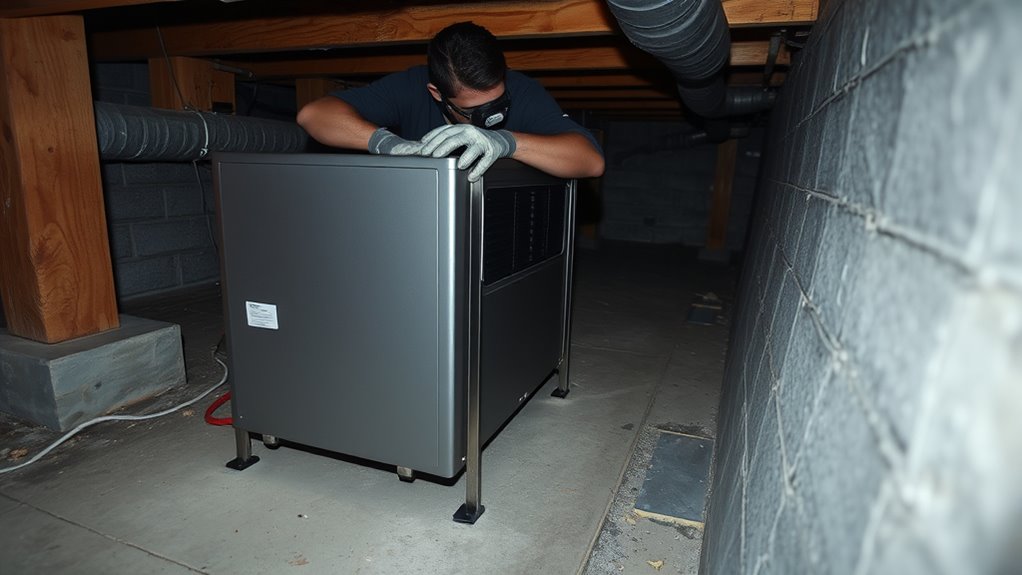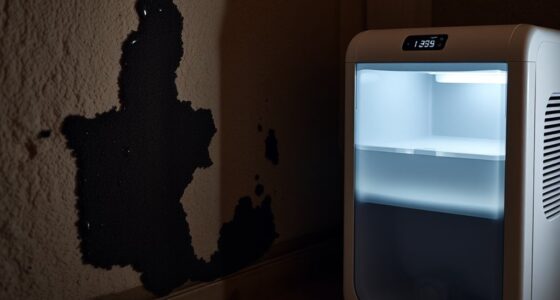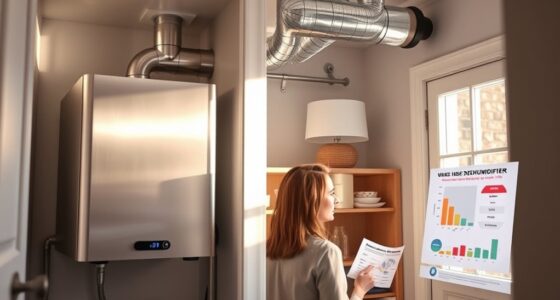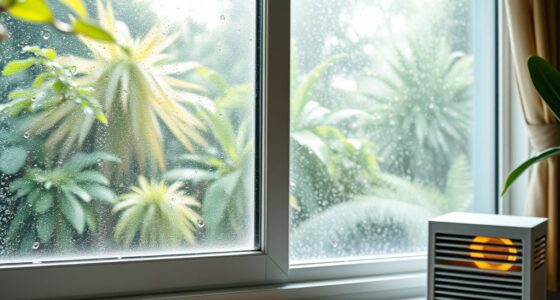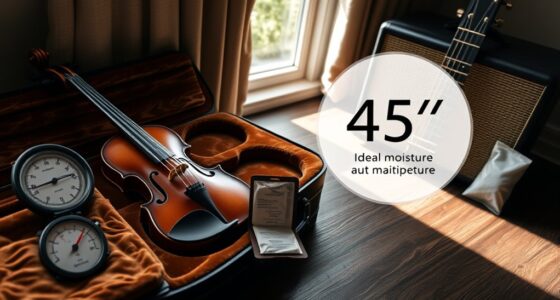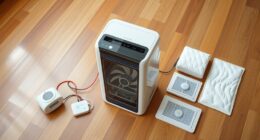To dehumidify your crawl space safely, choose a moisture-specific dehumidifier with enough capacity for your space. Place it on a level surface, away from debris, and connect it to an automatic drain or sump pump for continuous operation. Remember to turn off power before installation and wear protective gear during maintenance. Proper sealing, insulation, and ventilation also help improve moisture control. Keep exploring for detailed tips on installing and maintaining your system effectively.
Key Takeaways
- Choose a crawl space-specific dehumidifier with adequate capacity and energy efficiency for your space size.
- Install the dehumidifier on a level, stable surface, ensuring proper electrical wiring and grounding for safety.
- Seal all gaps around vents, pipes, and ducts to prevent moisture-laden air from entering the crawl space.
- Improve ventilation by adding vents or vent fans, and consider sealing vents during winter to avoid cold, moist air entry.
- Turn off power before installation or maintenance, wear protective gear, and consult professionals for mold or structural issues.
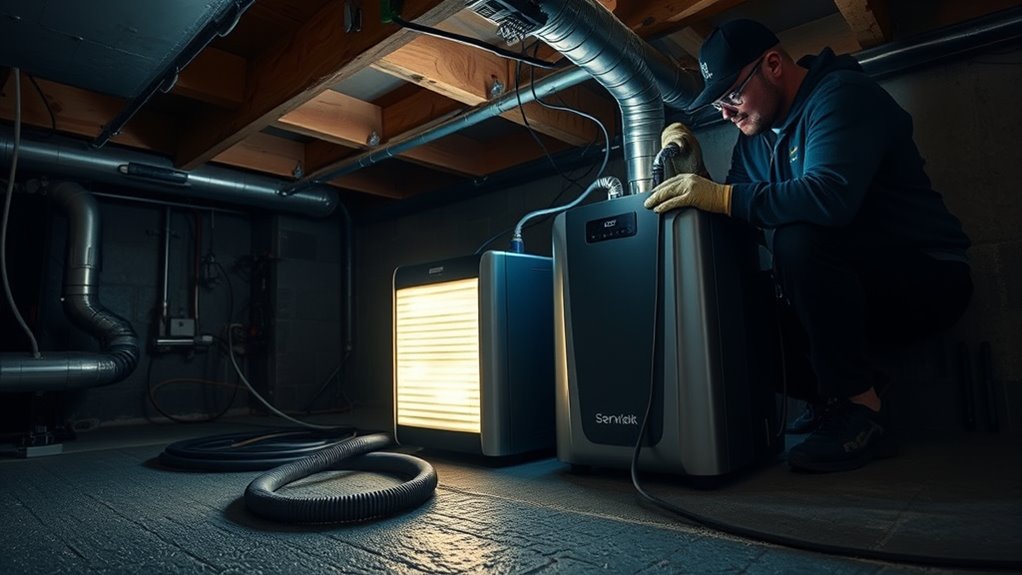
Crawl spaces often become damp and humid, which can lead to mold growth, wood rot, and poor air quality in your home. To prevent these issues, you need effective moisture control and proper ventilation strategies. Controlling humidity levels is vital because excess moisture encourages mold spores to thrive and accelerates wood decay. Installing a dehumidifier is one of the most efficient ways to keep humidity in check. When choosing a dehumidifier, look for one designed for crawl spaces, with enough capacity to handle the space’s square footage. Make sure it’s energy-efficient and equipped with a drain connection or a sump pump to eliminate collected water automatically.
Crawl space moisture control prevents mold, wood rot, and improves air quality.
Ventilation plays a key role in moisture control. Improving airflow helps reduce humidity and prevents stagnant, damp conditions. You should consider adding vents or installing a ventilation system that encourages air exchange between the crawl space and the outside. Proper ventilation strategies involve not only adding vents but also ensuring they’re correctly placed and unobstructed. Sometimes, sealing existing vents with vent covers or bags during the winter can prevent cold, moist air from entering, especially if outside humidity is high. Conversely, in warmer months, opening vents can promote air circulation, reducing moisture buildup. Using a combination of vent fans and passive vents can optimize airflow, especially if you experience high humidity levels regularly.
Another safety tip is to ensure that your crawl space is well-insulated and sealed. Proper insulation prevents warm, moist air from entering and condensing on cooler surfaces, which contributes to moisture problems. Seal any gaps around pipes, ducts, and vents to prevent air leaks that could carry moisture inside. When installing a dehumidifier, position it on a level surface, away from debris, and ensure it’s correctly wired and grounded to prevent electrical hazards. Regular maintenance, including cleaning filters and checking for leaks, is essential to keep your dehumidifier running efficiently and safely. Additionally, selecting a dehumidifier with a humidistat control allows for automatic regulation of humidity levels, enhancing energy efficiency and maintaining optimal conditions.
Always consider safety when working in crawl spaces. Turn off power before installing or servicing electrical equipment, and wear protective gear to guard against dust, mold, and pests. If your crawl space has significant mold or structural issues, consult professionals for remediation and ensure that your ventilation and dehumidification system is correctly installed. Proper moisture control combined with effective ventilation strategies not only protects your home’s structure but also improves indoor air quality, making your living environment healthier and more comfortable.
Frequently Asked Questions
How Often Should I Inspect My Crawl Space Dehumidifier?
You should inspect your crawl space dehumidifier at least once a month to make certain it’s functioning properly. Follow a simple maintenance frequency routine and use an inspection checklist to check for signs of wear, blockages, or leaks. Regular inspections help prevent mold, moisture buildup, and equipment failures. Staying proactive keeps your crawl space dry and safe, saving you money on repairs and ensuring maximum dehumidifier performance over time.
Can I Install a Dehumidifier Myself or Hire a Professional?
You can definitely do a DIY installation if you’re comfortable with basic electrical work and follow the manufacturer’s instructions carefully. However, if you’re unsure about any steps or want to ensure maximum safety and performance, hiring professional services is a smart choice. Professionals have the experience to install your crawl space dehumidifier correctly, reducing risks and ensuring it operates efficiently. Consider your skill level and comfort when deciding between DIY and professional installation.
What Size Dehumidifier Is Suitable for My Crawl Space?
To determine the right dehumidifier capacity for your crawl space, you need to ensure its size. Measure the total square footage and height of the space, then choose a dehumidifier rated for that size. For smaller crawl spaces, a unit with a capacity of around 30-50 pints may suffice, while larger areas might require 70 pints or more. Matching the dehumidifier capacity to your crawl space size ensures effective moisture control.
Are There Specific Safety Precautions During Dehumidifier Installation?
Imagine a quiet crawl space, suddenly disrupted by electrical sparks or fumes. During installation, you should prioritize electrical safety by turning off power and using grounded outlets. Confirm proper ventilation to prevent moisture buildup and reduce health risks. Keep the area clear of clutter, wear protective gear, and follow manufacturer instructions carefully. These precautions protect you from hazards while ensuring your dehumidifier functions safely and effectively.
How Do I Prevent Mold Growth After Dehumidifying?
To prevent mold growth after dehumidifying, you should focus on moisture control and mold prevention strategies. Make certain your crawl space stays dry by maintaining proper ventilation and sealing any leaks. Regularly check for excess moisture or water intrusion, and consider using a dehumidifier with a drain to keep humidity levels low. Keeping the area clean and well-ventilated discourages mold spores from settling and growing, protecting your space long-term.
Conclusion
Now that you know how to dehumidify your crawl space safely and effectively, imagine what could happen if you overlook these essential steps. Moisture lurking unseen can lead to costly structural damage or mold growth before you even realize it’s there. Are you ready to take control and protect your home? Don’t wait until it’s too late—act now and keep your crawl space dry, safe, and secure. The future of your home depends on it.
